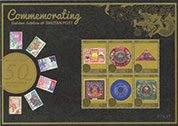The history of The British Empire and The Commonwealth can not be entirely told by a collection of Commonwealth stamps; sometimes one needs to venture in to obtaining the stamps of countries which have never been part of The Commonwealth or its imperial predecessor. This is especially true when events did not turn out as the British may have wished them to. An example of this are the events of 1806 to 1807 during which period British forces invaded and occupied what was later to become Argentina.
Until 1776, Argentina was part of the Spanish Viceroyality of Peru and Buenos Aires was a bustling, cosmopolitan city and so became the capital of the new Viceroyality of La Plata which incorporated what is now Argentina, Uruguay, Paraguay and southern Bolivia. The busy port was open to international trade and the city had become extremely wealthy with its population numbering 45000 by 1800. In 1790 the Venezualan revolutionary, Francisco Miranda, had put a plan to the British prime minister, William Pitt, to overthrow Spanish rule with British help in the form of troops and naval ships. Although Pitt was keen on the idea the plan eventually fell through but the Spanish grip on its South American possessions continued to weaken despite this. As the Napoleonic Wars were waged and the Spanish became allies of the French, the British attempted to assist Miranda in his attempts to put an end to Spanish rule but his expedition in which his forces actually landed in South America ended un failure and he took refuge in Trinidad.
At the beginning of 1806, the British under Admiral Sir Hope Popham were able to seize The Cape Of Good Hope from the Dutch who were also allies of Bonaparte and in April of that year Popham was told by Captain T. Wayne of the American slaver ship "Elizabeth" that the citizens of Buenos Aires and Montevideo were"groaning under the tyranny" of the Spanish and that they would welcome a British expedition to free them. Without British governmental approval Popham decided to invade La Plata and sailed westwards from The Cape with 1200 men aboard under the command of Major General William Carr Beresford. This number was boosted to 1460 officers and men after a call at St. Helena en route to the target of Buenos Aires.

The soldiers were mainly from the 1st Battalion, 71st Highland Light Infantry as well as 300 marines, dragoons and an artillery company. Troops were disembarked unopposed at Quilmes on 26 April 1806 and sent the 2000 Spanish troops there into retreat. The British marched on Buenos Aires with the Spanish Viceroy, the Marques de Sombremente, being among the first to flee the city in company with the city's leading merchant, Manuel Belgrano, who would later become an Argentinian hero. The city was surrendered to the British by General Jose Ignacio de la Quintana on generous terms since the British saw themselves as liberators rather than conquerors. The British promised that all private property would be unmolested by British soldiers, all private citizens would be protected, the Catholic religion would be honoured, local magistrates would continue to raise taxes as usual and captured vessels in the port would be returned to their owners together with their cargoes. However a vast amount of public property belonging to the Spanish Crown was seized.
The local people, however, were angry that the British had not declared them to be free with the result that insurrection against the British broke out under Pueridon. Santiago de Liniers y Bremond, a Knight of Malta in Spanish service, gathered forces from the outlying districts and marched on Buenos Aires and laid siege to the city. Large numbers of the city dwellers attacked the British troops inside the city and, under fierce assault and having lost 180 men, Beresford capitulated on 12 August 1806. Beresford and his troops were imprisoned inside the city but outside the campaign continued. British reinforcements under General Sir Samuel Auchmuty attacked and captured Montevideo in February 1807 (again the Marques of Sombremonte was distinguished by his hurried escape from that city) . Further British forces under General John Whitelocke were sent to retake Buenos Aires and the large force landed at Barragon on 28 June 1807.

An assault on the city took place on 5 July but suffered huge losses in the face of heavy resistance although by the end of the day the British were in control of large parts of the city. Liniers offered an exchange of prisoners to Whitelocke which included Beresford and his men and, to the disgust of many of his men, Whitelocke agreed to accept Liniers' terms. The British withdrew and on 9 September 1807, Whitelocke departed from Montevideo and the British attempt to establish itself as a power in South America came to an end. However, Spanish power in La Plata was irretrievably weakened and the locals themselves would soon be beginning their campaign for independence.
From 2006 to 2007, Argentina produced 3 stamp issues to commemorate the bicentenary of the liberation and defence of Buenos Aires. The first, a miniature sheet depicted at the top of this blog with the individual stamp taken from it also depicted above, was issued on 22 July 2006 and shows a painting of the dejected-looking British under Beresford surrendering Buenos Aires to the victorious locals under Liniers. A second issue which was released on 23 June 2007 is a single stamp which shows the defence of Buenos Aires against the attack by Whitelocke and his forces (also depicted above). Below I depict a single stamp issued on 9 September 2006 which commemorates the bicentenary of the founding of the infabtry force, the Patricios:-



















































